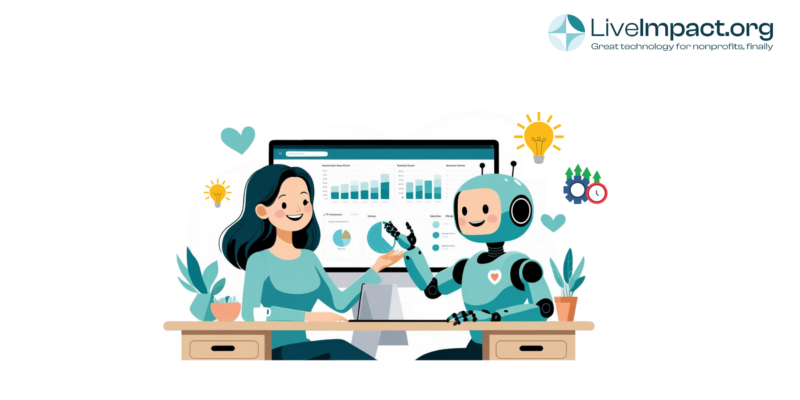1. What is “Co‑Intelligence”?
Co‑intelligence refers to thoughtfully combining human strengths with AI, not replacing one with the other. AI handles routine, repetitive, data-heavy, tedious tasks, while nonprofit staff provide oversight and judgment. It’s about creating a partnership to amplify impact. This is the approach that is recommended by many experts in nonprofit tech ethics.
2. Your Team at the Center
- AI is a boost, not a substitute. Staff members remain essential for validating results, adding context, and making final calls. AI technology is improving exponentially, but it is still not perfect. Every AI output should be reviewed by staff to catch errors, check for bias, and confirm alignment with mission and values.
- Train and support your team. Staff need basic AI fluency: understanding what AI can (and can’t) do, where mistakes can be made, and how to carefully review outputs. Depending on the specific AI tool, hallucinations and inaccuracies can be a problem. Make sure your staff understands the risks and correct use cases.
- Give your team capacity for mission critical tasks. Your staff are working for your nonprofit for one reason: to make an impact. AI, when properly used, can give your staff the time to focus on high-impact activities. Let them work with more clients, connect with more community members and donors, and make a bigger difference overall. You’ll soon realize the true potential of your team members when they’re not bogged down with time-consuming tasks.
3. Deploy Responsibly
- Start with the right questions. Rather than asking “How can we use AI?” nonprofits should ask: What specific problem do we need to solve? What will the process look like after implementation? Who will be responsible for process management and oversight?
- Consider any risks. There can be risks that come along with AI. Depending on which tool you choose to use, you could be putting your organization and its sensitive data in danger. Be sure to do due diligence on the specific AI model. Make sure you know how it’s trained and what its security policies are before exposing any of your confidential data.
- Verify each deployment. Pilot projects should include accuracy checks and staff reviewing AI outputs before full rollout. Test out processes and workflows ahead of time to make sure that everything is working as intended.
4. Build Trust Through Transparency
- Be honest with donors, board, volunteers, and clients about how AI is used and how staff oversee it.
- Use reporting tools that show AI impact and human validation.
- Conduct ongoing reviews to ensure AI continues to be safe and accurate.
5. Talk with a Professional Advisor
LiveImpact offers a free, no-obligation consultation to explore how your nonprofit could benefit from AI. Set up a meeting with us to discuss:
- A second opinion on your strategy,
- Help designing pilot projects,
- Guidance on oversight, data protection, and staff training.
Putting It All Together
AI is not a magic fix. It’s a powerful tool when built responsibly and monitored carefully. With co‑intelligence, nonprofits get the best of both worlds: AI‑powered efficiency and human‑driven wisdom. This is how you use AI to supercharge your mission.


